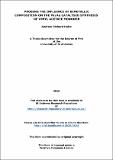Files in this item
Probing the influence of bimetallic composition on the Pd/Au catalysed synthesis of vinyl acetate monomer
Item metadata
| dc.contributor.advisor | Baddeley, Christopher J. | |
| dc.contributor.author | Haire, Andrew Richard | |
| dc.coverage.spatial | 191 | en_US |
| dc.date.accessioned | 2010-09-22T15:18:02Z | |
| dc.date.available | 2010-09-22T15:18:02Z | |
| dc.date.issued | 2010-06 | |
| dc.identifier | uk.bl.ethos.552369 | |
| dc.identifier.uri | https://hdl.handle.net/10023/1018 | |
| dc.description.abstract | Scanning Tunnelling Microscopy (STM) was utilised together with the high resolution depth-profiling capabilities of Medium Energy Ion Scattering (MEIS), a technique traditionally associated with single crystal substrates, to probe the mean size and depth dependent composition profile of bimetallic PdAu nanoparticles on planar oxide surfaces as functions of the starting composition and annealing temperature. In order to fit composition profiles to experimental MEIS data, a new analysis tool has been designed that models the particles as flat-topped structures with a hexagonal base which can be divided into a number of shells, each shell corresponding to a particular ion pathlength inside the material. The reliability of this method will be discussed in detail. Fitting results show that the surface layers are always significantly enriched in Au compared to the bulk alloy composition. By comparing MEIS data for clean surfaces data for modified surfaces it was found that Pd generally segregates towards the particle surface on adsorption of acetic acid. The interaction of potassium acetate with Au/Pd{111} alloy surfaces of varying composition has been investigated using Temperature Programmed Desorption (TPD) and Reflection Absorption Infra Red Spectroscopy (RAIRS). At lower coverage, potassium acetate reacts reversibly with the surface to form CO and carbonate. Formation of surface acetate is observed on Pd-rich surfaces only. At higher coverage, acetate is the major surface species formed on all samples examined. | en_US |
| dc.language.iso | en | en_US |
| dc.publisher | University of St Andrews | |
| dc.rights | Creative Commons Attribution-NonCommercial-NoDerivs 3.0 Unported | |
| dc.rights.uri | http://creativecommons.org/licenses/by-nc-nd/3.0/ | |
| dc.subject | Vinyl acetate | en_US |
| dc.subject | MEIS | en_US |
| dc.subject | Nanoparticles | en_US |
| dc.subject | Pd/Au alloy | en_US |
| dc.subject.lcc | TP1180.V48H2 | |
| dc.subject.lcsh | Vinyl acetate--Synthesis | en_US |
| dc.subject.lcsh | Metal catalysts | en_US |
| dc.subject.lcsh | Surfaces (Technology)--Analysis | en_US |
| dc.subject.lcsh | Palladium alloys | en_US |
| dc.subject.lcsh | Gold alloys | en_US |
| dc.subject.lcsh | Nanoparticles | en_US |
| dc.title | Probing the influence of bimetallic composition on the Pd/Au catalysed synthesis of vinyl acetate monomer | en_US |
| dc.type | Thesis | en_US |
| dc.contributor.sponsor | Engineering and Physical Sciences Research Council (EPSRC) | en_US |
| dc.contributor.sponsor | BP Chemicals International Limited | en_US |
| dc.type.qualificationlevel | Doctoral | en_US |
| dc.type.qualificationname | PhD Doctor of Philosophy | en_US |
| dc.publisher.institution | The University of St Andrews | en_US |
This item appears in the following Collection(s)
Except where otherwise noted within the work, this item's licence for re-use is described as Creative Commons Attribution-NonCommercial-NoDerivs 3.0 Unported
Items in the St Andrews Research Repository are protected by copyright, with all rights reserved, unless otherwise indicated.


